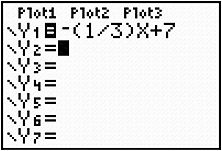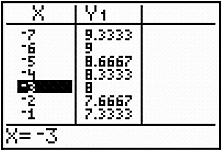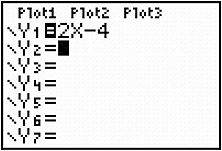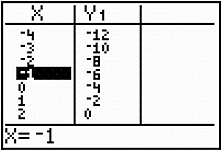
You can also use the table feature on your graphing calculator to find solutions to linear equations and inequalities.
Let's say that you are asked to determine if (-3, 8) is a solution to 3y + x = 7.
Step 1:
Enter the equation in 
Remember that first we will need to write the equation in y = form.
Our equation will be y = - 1 3 x + 7 or y = 7 − 1 3 x

Step 2:
Look at the table for this equation by pressing  to access the
to access the  and scroll up the table until you see an x-value of -3.
and scroll up the table until you see an x-value of -3.

Our table shows that when x = -3, y = 8.
So the ordered pair (-3, 8) IS a solution to the equation.
Let's look at a linear inequality next.
Is (-1, -6) a solution for 4x − 2y > 8?
Step 1:
Enter the equation in 
Remember that first we will need to write the equation in y = form.
Our equation will be:


Step 2:
Look at the table for this equation by pressing  to access the
to access the  and scroll up the table until you see an x-value of -1.
and scroll up the table until you see an x-value of -1.

Our table shows that when x = -1, y = -6. REMEMBER: we are solving an inequality. So we need to ask "Is y < 2x – 4?"
y < 2x − 4
-6 < 2(-1) − 4
-6 < -2 − 4
-6  -6
-6
So (-1, -6) is NOT a solution to the inequality.
Use the Table feature on your calculator and determine if the given ordered pair is a solution to each linear equation or inequality.
When you are finished, click below to check all of your answers.
Interactive popup. Assistance may be required.Answer to question 1: Yes
Answer to question 2: No
Answer to question 3: Yes
